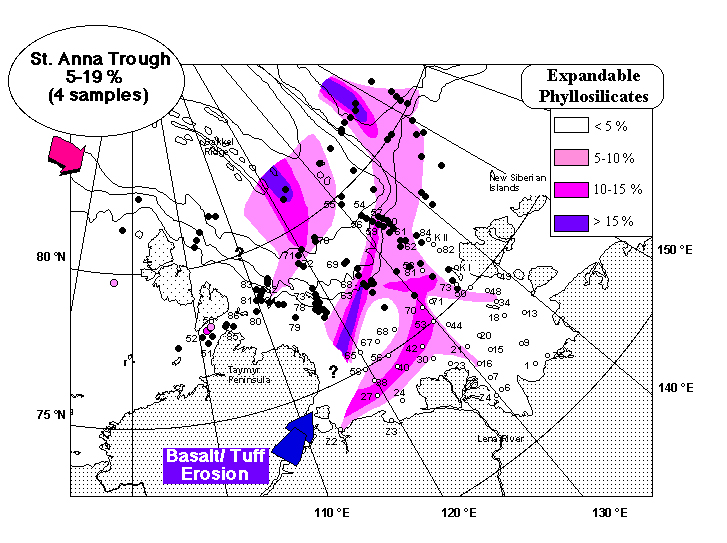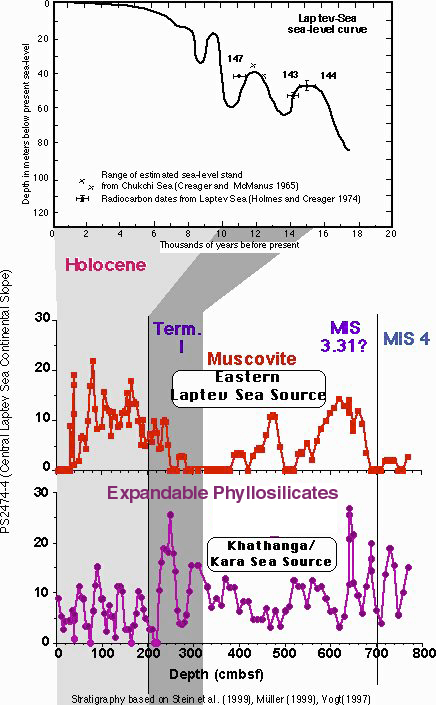A New Approach for the X-ray Diffraction Based Quantification of Mineral Assemblages
in the Eurasian Shelves and the Arctic OceanChristoph Vogt , Geosciences/ FB Geowissenschaften, Universität Bremen, Klagenfurter Str., D-28359 Bremen, Germany, email: cvogt@uni-bremen.de, Webpages: http://www.geo.uni-bremen.de/kristall/cvogt/cvogtCV.html
Hundreds of surface samples of the Arctic Ocean and adjacent shelf regions were investigated and analyzed by means of X-ray diffraction and the QUAX software (Quantitative Phase-Analysis with X-ray Powder Diffraction). QUAX has successfully been used at the KTB site (German Continental Deep Drilling) to determine mineral assemblages fast and automatically on a huge amount of samples (> 40,000). During the last years the full pattern database of QUAX has been adapted to the investigation of young and poorly crystalline sediments, in particular those of the Arctic Ocean which contain high amounts of clay minerals.Quantification of the clay minerals from the bulk sediment is highly desirable due to their importance for paleoceanographic reconstruction. Determination of the clay minerals from the clay fraction is extremely variable depending on the laboratory routine. Separation of the clay fraction and further laboratory processing make it extremely difficult to recalculate the content of a particular clay mineral in the bulk sediment. Hence, sedimentation and accumulation rates of a distinct clay mineral contain variable and large systematical errors. Determination of clay minerals are performed rather in a qualitative than quantitative manner.
A paleoceanographic reconstruction of source material, sedimentation and sediment transport can only be based on differences between the source regions. Luckily, the source regions for the Eurasian Arctic Ocean, the Barents, Kara and Laptev Sea show these differences in mineralogy. Clay minerals are extremely well suited to determine ocean current transport and the riverine input of the large Siberian river and sea ice transport. The inner Kara and Western Laptev Sea exhibit a very important marker mineralogy (Fig. 1). The clay mineral assemblage is dominated by smectites and montmorillonites from the erosion of the Putorana Siberian Flood Basalts and tuffites. The material is transported to both shelf regions by the Yenisei and Khathanga river systems, respectively. Contrarily, the Eastern Laptev Sea shows an illite/mica and chlorite dominated clay mineral assemblage transported to the Laptev Sea by the Lena river.
Fig. 1 Distribution of expanable clay minerals (sum of smectites, montmorillonites and expanable mixed-layer clays) in the bulk fraction of surface sediments of the Laptev Sea (inner Laptev Sea samples: Transdrift I cruise (Kassens and Karpiy 1994) continental slope and Arctic Ocean samples: RV "Polarstern" cruises ARK-IX/4 (Fütterer 1994) and ARK-XI/1 (Rachor 1997)). The content of phyllosilicates in the bulk fraction also depends on the grain size distribution. Coarse, sandy material like in the surface samples IK9365-68 obscure the comparison to the well know clay fraction distribution of clay minerals (Wahsner et al. 1999; Boreas, Vol. 1).
In sediment cores from the Laptev Sea continental slope distinct changes in clay mineral assemblages in the bulk fraction are indicative of the early flooding of the Western Laptev Sea and/ or the Kara Sea and the late flooding of the eastern Laptev Sea during the last glacial to Holocene transgression (Fig. 2). The recognition of high amounts of smectites and montmorillonites (the expandable phyllosilicates) with western Laptev Sea/ Kara Sea provenance in the Laptev Sea slope sediments during the very early Termination I implies early redistribution of the material from the inner shelfs during the early deglacation between 15,000 and 13,500 radiocarbon years. If the material derived from the Kara Sea no ice sheet could have persisted in the Eastern Kara Sea. The existence and extent of this ice sheet is currently strongly under discussion, e.g. in the QUEEN community. The high contents of mica the early and midle Holocene sediments might be related to the flooding of the Eastern Laptev Sea and the reworking of Lena derived material.
Fig. 2 Data of sediment core PS2474-4 from the western central continental slope of the Laptev Sea compared to a sea-level record of the Laptev Sea (Silverberg 1972).
Detailed age models of the Laptev Sea continental slope cores might enable us to calculate flux rates of the each destinct mineral and finally estimate mass transports in the region. Interestingly, the deglacial record at the boundary of Marine Isotope Stages 4 and 3 show similar developments in the mineral assemblage of the sediment core as Termination I.
This study is supported by the Deutsche Forschungsgemeinschaft (grant Fi 442-6/3,-6/4 to Reinhard X. Fischer and Ruediger Stein) and the Alfred Wegener Institute for Polar and Marine Research, Bremerhaven. References and further information (partly in German) can be found at our homepages.

